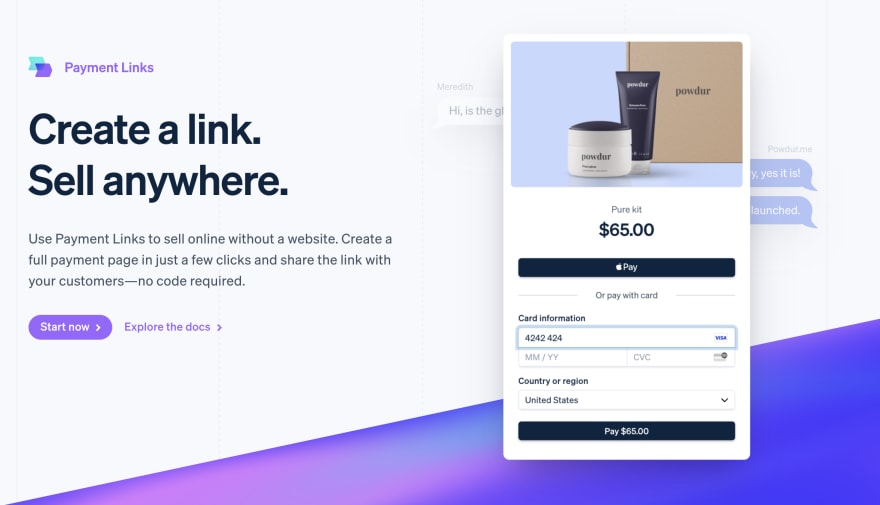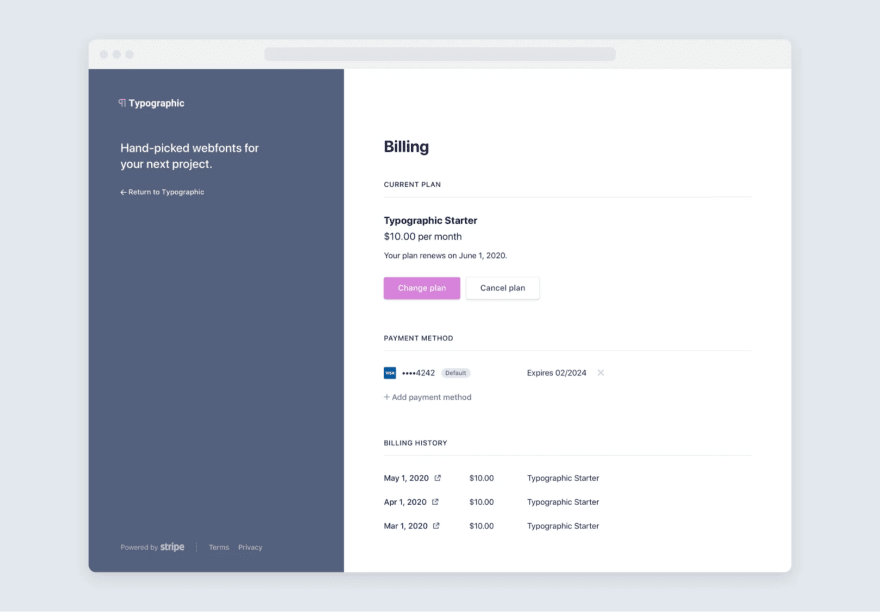An Interest In:
Web News this Week
- April 2, 2024
- April 1, 2024
- March 31, 2024
- March 30, 2024
- March 29, 2024
- March 28, 2024
- March 27, 2024
Strategies for building products with no code
Ive been a software developer for most of my life. Through a bit of dumb luck, I enrolled in a Computer Science class my freshman year of high school, where I learned Visual Basic. At the end of that school year, I was hired by a local company to help build their reporting products. Since then, I have gotten to work with some incredible teams, and founded several of my own companies. I am extremely lucky, and have benefitted immensely from learning to code.
Fairly regularly, I get messages from people who have an idea for an app or a product they want to build, asking what language they need to learn, or which code school they should enroll in to make their dreams come true.
Heres the thing: you dont have to become a developer to build products online.
There are many platforms and services available that allow you to build a product without needing to code, or be a programmer. These platforms provide the tools and infrastructure for you to create and launch products. These are sometimes referred to as no-code tools (some popular examples include Bubble, Webflow, and Zapier), and there are amazing communities online supporting them, like Apps Without Code and the No Code group on Indiehackers. You can find endless tutorials on building websites with no-code tools on YouTube. If you dont have a web presence yet, thats a fantastic place to start!
Youll need an idea, some creative vision, the tenacity to try things out, and the willingness to change when things arent working like you expected. Look no further than yourself - you can use your interests, knowledge and unique life experience to create and deliver products and services that people will pay for.
Here are some steps to take toward monetizing your expertise:
Find a niche

I had never heard of Pickleball until recently! Looks like fun.
Focus on a specific area that you know well. This will make it easier to create products and services that meet the needs of your target market. Think about your passions, and the communities youre a part of as a result of your interests. Maybe youre really into Pickleball, or youve been a watch collector all your life, or youve been growing exotic house plants for years. What are the things that stir your enthusiasm?
Once youve found a niche to focus on, its helpful to spend some time observing, listening, and taking notes on what you see - this can help guide you to creating a product which people will want to pay you for.
Get to know the community
After spending time learning about your niche, you will inevitably start to notice repeating patterns in behavior and questions among community members. Youll find people working through the same problems over and over, and beginners learning the ropes by making the same mistakes as people who have come before them. This is a great time to turn a critical eye on what youve seen in this niche as compared to other areas of your life. Have you seen recurring problems or discussions in the community that you might be able to help solve? Is there a steep learning curve for beginners, or to grow mastery in the space? Keep an eye out for places where your knowledge can be helpful, or where automation might be valuable, or where you solve problems by tying together existing patterns or solutions.
Its worth noting that it takes intention and practice to be able to identify product-building opportunities, even if youre an expert in a particular space. I tend to take notes when Im learning about something new. Seeing the same questions I had show up again and again when other people learn the ropes of a particular topic is a good sign that theres room for improvement.
Solve a problem
Think about what you can offer that will solve a problem or meet a need for your target market. Maybe youve been a part of the community for a long time, and youre uniquely positioned to create a course, or podcast, or ebook, or a paper for people just getting started in the community. Perhaps theres a few disjoint problems that can be solved by tying together a few disparate services with some simple automation. Maybe the community is just lacking organization - in cases like this, a weekly roundup newsletter, or a podcast, or a regularly produced video series can find a fairly impassioned audience.
Assess whether you can deliver value
As you identify potential problems to solve with a product, service, or offering of your design, it is important to look at whether or not you're delivering value for your audience:
- Pay attention to your research: Make sure you have a firm understanding of your audience, their needs, their desires, and an appetite or ability to pay for something youve built. This will help you to determine whether or not your product, service, or offering is delivering value.
- Be honest with yourself: Be critical of your own ideas, and ask yourself if you would use or pay for what you're offering. If the answer is no, then it's likely that your audience won't either.
- Ask for feedback: Get input from others on your product, service, or offering. Ask family and friends for their honest opinions. Poll your target market on Twitter, Facebook, Reddit, Discord, or wherever the community gathers. Use this feedback to help you determine whether or not you're delivering value.
Share your product story while you build it
Tell people what youre building, long before it is ready to sell. Ideally, start sharing ideas about your product from the moment it is conceived. For many first-time founders and new creators, this is often exactly the opposite of their intuition. Share your work with the world - tell people what youre working on, share your successes, learnings, and failures along the way. This is a great way to build an audience early on, and a useful tool to hold yourself accountable. Youll slowly but surely grow an audience of supporters from the network effect of engaging with people online.
It is a typical knee-jerk reaction to want to keep your project secret, and not reveal your product to the world until it is ready to launch. This is often born from a fear that someone else will come along and steal your idea, or that your idea will be seen as silly or useless. Friends, I am here to tell you: you have way more to gain from sharing your product creation journey than from keeping it secret! Many, many projects fail because the team building them keeps everything a secret until launch day.
Countless hours are invested in building great products, making sure every requirement is complete and every detail is meticulously preened, without sharing a single detail about the product with the world. Then, launch day comes, and crickets. It is really difficult to get people excited about something that nobody has heard about. By not building hype for your product from day 1, youre setting yourself up for failure.
Good enough comes sooner than you think
Many creators are surprised to find out that their earliest customers will use an imperfect product. If youre building something that people want, quite often theyll look past imperfections and pay you, especially if youre providing value for their interests and pain points. This is why its so important to get feedback early and often on your product. The earlier you share your plans, the easier it is to make changes and adaptations to your plans so the sooner you get feedback, the easier it is to improve your product.
The best feedback comes from paying customers. The second best feedback comes from your potential customers. In order to find these people, youre going to have to put yourself in front of your audience - and a great way to do that is by putting yourself out there, and seeing if people will pay for what youve made.
Get paid
There are a number of ways to monetize your products and services, so find the one that best suits your business. When its time to actually sell your products, you can take advantage of some of Stripes no-code/low-code tools to get paid without having to spend hours dealing with ecommerce setup.
Payment Links
Payment Links allow you to set up a unique URL to share with customers for a specific product (or set of products). It takes less than 5 minutes to create a payment link for a product, and you can create as many as you need.
Customer Portal
The Customer Portal lets your customers self-manage their subscriptions. This lets them adjust quantities, and update their subscriptions. At the time of writing this article, we are running a closed beta for a no-code version of the customer portal - which means youll be able to take advantage of all of this functionality without having to write a single line of code! If youre interested in trying this out, send an email to [email protected]
Pricing Tables
Stripe is also beta testing an Embeddable pricing table for SaaS businesses - this allows you to create a pricing table, so that your potential customers can compare plan features and pricing structures. Check out the docs to see a detailed breakdown of pricing table features, and get in touch with [email protected] to request access.
Wrapping up - you can do it!
Youve got more power at your fingertips than ever before - building products and making money online no longer requires a Computer Science degree. No code tools make it far more accessible for all of us to turn our expertise into a product. If youve ever been interested in sharing your knowledge with the world, now is a great time to start. You dont have to get bogged down in learning HTML and JavaScript and CSS to make something happen. Get started building something valuable now. I believe in you!
More Reading
- Some of this article is inspired by patterns described in The Embedded Entrepreneur, by Arvid Kahl. Arvid is an expert on getting to know a community, solving a problem, and turning that into a successful business.
- If youre interested in becoming a solo founder, I think youll really enjoy Company of One, by Paul Jarvis. Its a great handbook for founders looking to scale their business to sustain their lifestyle, rather than the Unicorn dream that many startups aim for
- If youre really itching to dive into this world head first, take a look at 30x500 Academy - they offer an intensive course on building a product, and have a well-defined strategy for launching your product while building an engaged audience.
- If you want to learn more about no-code tools, you might like my recent article on selling products using NFC tags.
Stay connected
You can stay up to date with Stripe Developer updates in a few ways:
Follow @StripeDev and our team on Twitter
Subscribe to StripeDevelopers on YouTube
Join the official Discord server
Sign up for the Stripe Dev Digest
About the author

Mike Bifulco (@irreverentmike) is a Developer Advocate at Stripe. He's also a serial entrepreneur, host of the APIs You Won't Hate podcast, and an espresso fanatic. Mike writes about product design and building with React on his own site, mikebifulco.com.
Note: Pickleball photo by Joan Azeka on Unsplash
Original Link: https://dev.to/stripe/you-dont-need-to-code-to-build-a-product-2jef
Dev To
 An online community for sharing and discovering great ideas, having debates, and making friends
An online community for sharing and discovering great ideas, having debates, and making friendsMore About this Source Visit Dev To




